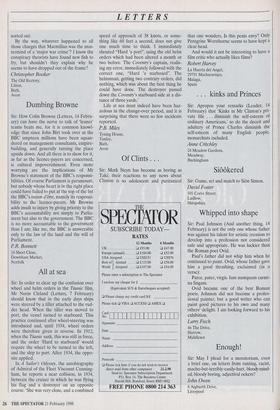All at sea
Sir: In order to clear up the confusion over wheel and helm orders in the Titanic film, Mr Norm Cleland (Letters, 7 February) should know that in the early days ships were steered by a tiller attached to the rud- der head. When the tiller was moved to port, the vessel turned to starboard. This practice continued after wheel-steering was introduced and, until 1934, wheel orders were therefore given in reverse. In 1912, when the Titanic sank, this was still in force, and the order 'Hard to starboard' would require the wheel to be turned to the left, and the ship to port. After 1934, the oppo- site applied.
In A Sailor's Odyssey, the autobiography of Admiral of the Fleet Viscount Cunning- ham, he reports a near collision, in 1934, between the cruiser in which he was flying his flag and a destroyer on an opposite course. She was very close, and a combined speed of approach of 38 knots, or some- thing like 60 feet a second, does not give one much time to think. I immediately shouted "Hard 'a port", using the old helm orders which had been altered a month or two before. The Coventry's captain, realis- ing my error, immediately followed with the correct one, "Hard 'a starboard". The helmsman, getting two contrary orders, did nothing, which was about the best thing he could have done. The destroyer passed down the Coventry's starboard side at a dis- tance of three yards.'
Life at sea must indeed have been haz- ardous in the change-over period, and it is surprising that there were so few incidents reported.
P.B. Miles
Tyning House, Tunley, Bath, Avon


























































 Previous page
Previous page